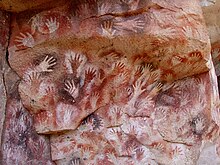
Back استخدام إحدى اليدين Arabic Пераважная рука Byelorussian হস্তপ্রাধান্য Bengali/Bangla Desnorukost/ljevorukost BS Dretà Catalan چەپدەست CKB Händigkeit German Manprefero Esperanto Mano dominante Spanish Käelisus Estonian


In human biology, handedness is an individual's preferential use of one hand, known as the dominant hand, due to it being stronger, faster or more dextrous. The other hand, comparatively often the weaker, less dextrous or simply less subjectively preferred, is called the non-dominant hand.[2][3][4] In a study from 1975 on 7,688 children in US grades 1–6, left handers comprised 9.6% of the sample, with 10.5% of male children and 8.7% of female children being left-handed.[5][6][7] Overall, around 90% of people are right-handed.[8] Handedness is often defined by one's writing hand, as it is fairly common for people to prefer to do a particular task with a particular hand. There are people with true ambidexterity (equal preference of either hand), but it is rare—most people prefer using one hand for most purposes.
Most of the current research suggests that left-handedness has an epigenetic marker—a combination of genetics, biology and the environment.
Because the vast majority of the population is right-handed, many devices are designed for use by right-handed people, making their use by left-handed people more difficult.[9] In many countries, left-handed people are or were required to write with their right hands. However, left-handed people have an advantage in sports that involves aiming at a target in an area of an opponent's control, as their opponents are more accustomed to the right-handed majority. As a result, they are over-represented in baseball, tennis, fencing,[10] cricket, boxing,[11][12] and mixed martial arts.[13]
- ^ Podestá, María Mercedes; Raffino, Rodolfo A.; Paunero, Rafael Sebastián; Rolandi, Diana S. (2005). El arte rupestre de Argentina indígena: Patagonia (in Spanish). Grupo Abierto Communicaciones. ISBN 978-987-1121-16-8. Archived from the original on 2021-10-29. Retrieved 2021-03-01.
- ^ Holder MK. "What does Handedness have to do with Brain Lateralization (and who cares?)". Archived from the original on 2013-03-26. Retrieved 11 August 2012.
- ^ "dominant". Merriam-Webster Dictionary. Merriam-Webster. Archived from the original on 8 March 2017. Retrieved 8 March 2017.
4 : biology : being the one of a pair of bodily structures that is the more effective or predominant in action • dominant eye • used her dominant hand
- ^ "non-". Merriam-Webster Dictionary. Merriam-Webster. Archived from the original on 8 March 2017. Retrieved 8 March 2017.
Definition of non- 1 : not : other than : reverse of : absence of • nontoxic • nonlinear
. ("Nondominant" is one of 945 words listed under "non-") - ^ Hardyck, C.; Petrinovich, L. F.; Goldman, R. D. (September 1976). "Left-handedness and cognitive deficit". Cortex. 12 (3): 266–279. doi:10.1016/s0010-9452(76)80008-1. PMID 1000995. S2CID 4477753.
- ^ Scharoun SM, Bryden PJ (2014). "Hand preference, performance abilities, and hand selection in children". Frontiers in Psychology. 5 (82): 82. doi:10.3389/fpsyg.2014.00082. PMC 3927078. PMID 24600414.
- ^ Papadatou-Pastou, Marietta; Ntolka, Eleni; Schmitz, Judith; Martin, Maryanne; Munafò, Marcus R.; Ocklenburg, Sebastian; Paracchini, Silvia (June 2020). "Human handedness: A meta-analysis". Psychological Bulletin. 146 (6): 481–524. doi:10.1037/bul0000229. hdl:10023/19889. PMID 32237881. S2CID 214768754.
- ^ Pfeifer, Lena Sophie; Schmitz, Judith; Papadatou-Pastou, Marietta; Peterburs, Jutta; Paracchini, Silvia; Ocklenburg, Sebastian (15 January 2022). "Handedness in twins: meta-analyses". BMC Psychology. 10 (1): 11. doi:10.1186/s40359-021-00695-3. PMC 8760823. PMID 35033205.
- ^ Cite error: The named reference
:2was invoked but never defined (see the help page). - ^ Harris, Lauren Julius (January 2010). "In fencing, what gives left-handers the edge? Views from the present and the distant past". Laterality. 15 (1–2): 15–55. doi:10.1080/13576500701650430. PMID 20391153.
- ^ Richardson, Thomas; Gilman, R. Tucker (28 October 2019). "Left-handedness is associated with greater fighting success in humans". Scientific Reports. 9 (1). Nature Portfolio: 15402. Bibcode:2019NatSR...915402R. doi:10.1038/s41598-019-51975-3. PMC 6817864. PMID 31659217.
- ^ Guy, Jack (25 February 2019). "Left-handed boxers win more fights, research shows". CNN. Retrieved 6 December 2022.
- ^ "Why are left-handed people better fighters?". ITV News. 2019-02-25. Retrieved 2021-03-01.